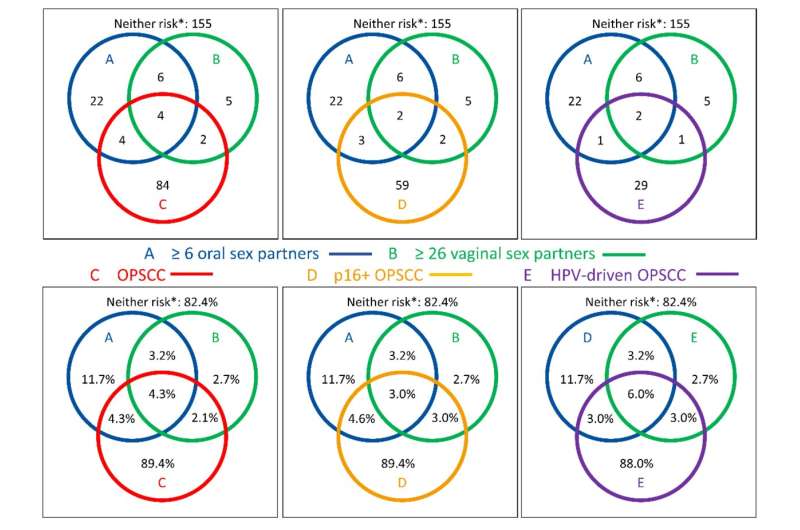This article has been reviewed according to Science X's editorial process and policies. Editors have highlighted the following attributes while ensuring the content's credibility:
fact-checked
trusted source
proofread
Study investigates link between oropharyngeal cancer and sexual behavior

The development of head and neck cancer is increasingly linked to HPV infection, which is a sexually transmitted disease. Oropharyngeal cancer is a type of head and neck cancer that is associated with preconceptions regarding the high-risk sexual behavior of the affected individuals.
Circumventing some potential sources of bias related to case-control studies, researchers at Leipzig University conducted a nested case-control study which utilized consecutive accrued oropharyngeal squamous cell carcinoma (OPSCC) cases and matched healthy controls from the LIFE population-based cohort study to answer the question of whether high-risk sexual behavior is a relevant aetiologic factor in the development of HPV-related OPSCC.
Human papillomavirus (HPV) is a ubiquitous virus, and most people are infected at some point in their lives. HPV can infect epithelial cells of the skin and mucosa at various sites. There are more than 100 known HPV subtypes, most of which cause only benign lesions such as warts and condyloma. Thanks to a well-functioning immune response, most people who are infected don't develop serious symptoms.
However, some HPV subtypes are not so harmless. These subtypes, and especially subtype HPV16, can transform infected cells to become neoplastic, and these malignant transformed cells then develop into precancerous lesions or even cancer. The development of head and neck cancer, and oropharyngeal cancer in particular, is also deemed to be etiologically linked to HPV.
As HPV infections are transmitted during sexual activities, HPV-associated cancers like cancer of the uterine cervix and oropharyngeal cancer, as well as penile, vulvar and anal cancer are considered sexually transmitted diseases (STDs). About one-third of oropharyngeal cancers diagnosed in Germany are attributed to HPV.
Patients with oropharyngeal cancer are often assumed to have high-risk sexual behavior and an increased number of oral sex partners. Some high-ranked publications from the United States have significantly contributed to this perception by repeatedly reporting a substantially increased prevalence of oral and vaginal sex partners in patients with HPV-related oropharyngeal cancer.
In the current study, 303 healthy controls from the LIFE population-based cohort study were invited and interviewed, and their responses were compared with those of 317 patients with head and neck cancer who are also part of the LIFE Study.
"Our current study relativizes the previous view of HPV-associated oropharyngeal cancer as a disease that people get who engage in high-risk sexual behavior and have a significantly higher number of sex partners, in particular, oral sex partners. The sexual behavior of our patients with HPV-driven oropharyngeal cancer does not deviate from that of other head and neck cancer patients and especially not from that of the matched healthy controls," says Professor Andreas Dietz, director of the ENT Department and professor for otorhinolaryngology at Leipzig University.
The study was published in the journal Cancers. "Our research points to a set of risk factors for oropharyngeal cancer that can be prevented. These include smoking and drinking large amounts of alcohol on a daily basis. Protection can also be achieved by vaccinating both sexes against HPV as early as possible," says Dr. Gunnar Wichmann, lead author and head of the ENT Research Lab at the University of Leipzig Medical Center.
Sexual transmission of the infection is of utmost importance as the study revealed that patients who developed HPV-driven oropharyngeal cancer were more likely to have been sexually active before the age of 18. "In this regard, it is highly recommended that both girls and boys are vaccinated early and before puberty," says Professor Dietz. Vaccines against HPV are approved for girls and boys from the age of nine, and the cost of vaccinations before the age of 18 are covered by all statutory health insurance companies.
More information: Gunnar Wichmann et al, Is High-Risk Sexual Behavior a Risk Factor for Oropharyngeal Cancer?, Cancers (2023). DOI: 10.3390/cancers15133356


















